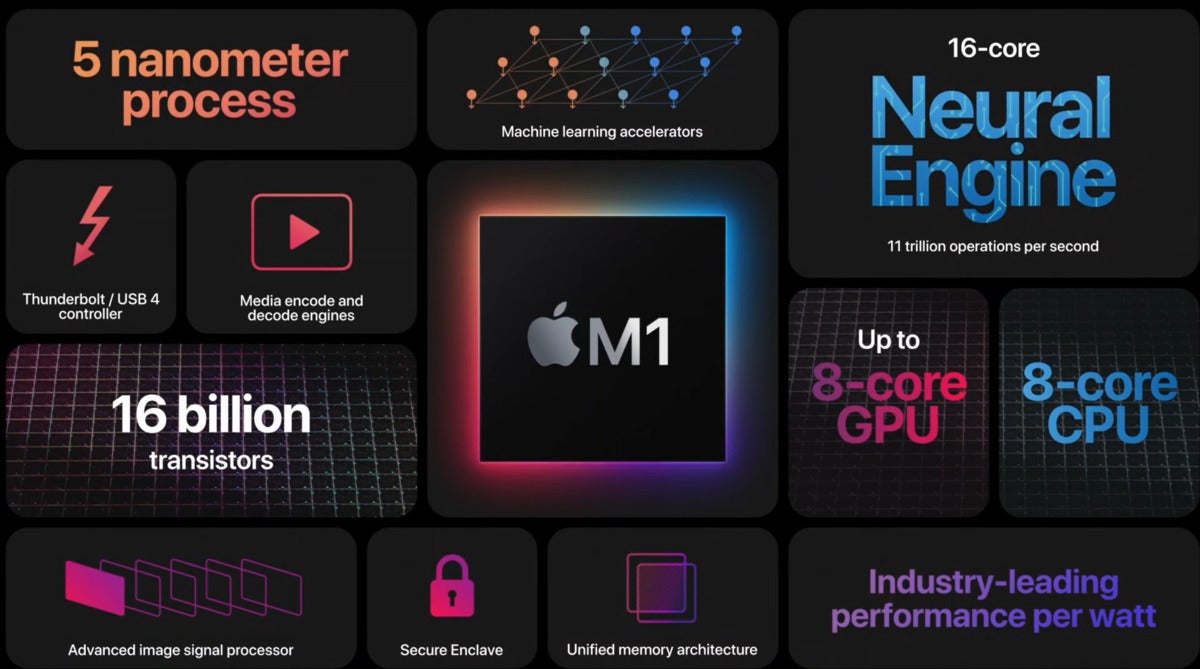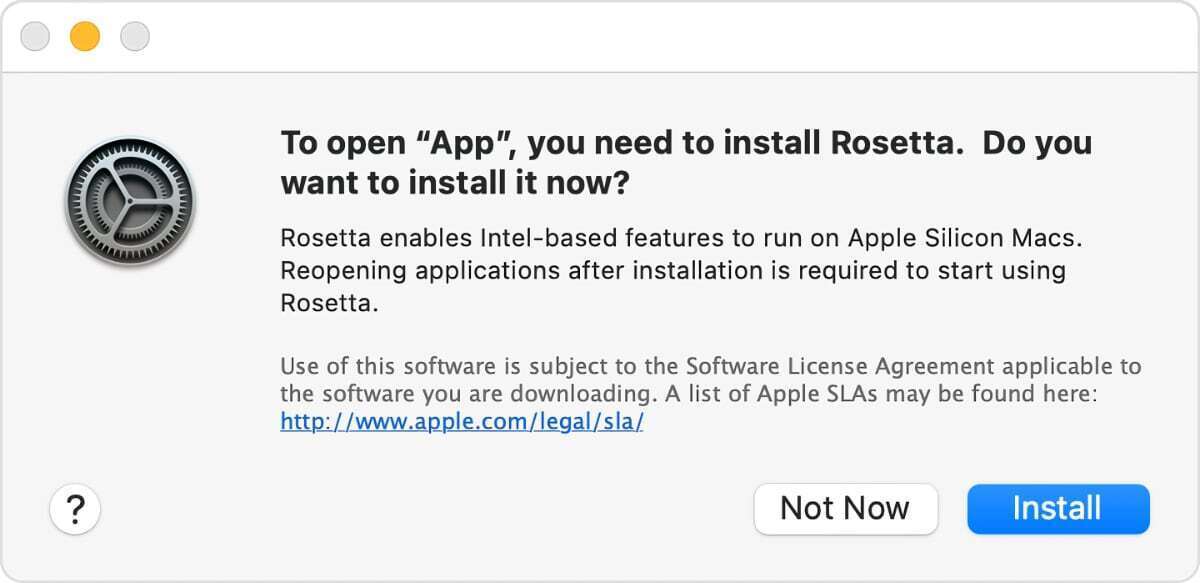 Credit: Apple
Credit: Apple
Macs are undergoing a big change. Apple is switching its internal architecture from one that uses Intel CPUs, third-party graphics processors, and other parts, to the company’s own “system on a chip.” The first Apple silicon SoC for Macs is called the M1.
It’s a big step for Apple and the Mac. But what does it mean for you? In this article, we cover what Apple’s system on a chip means to the user, how it affects what software you can use, and answer other frequently asked questions. We will update this whenever there are new developments.
What is the ‘Apple silicon’ M1 system on a chip?
“Apple silicon” refers to the chips Apple makes. In the Mac, they replace the Intel processors they have used for the past 14 years, and will eventually also replace the AMD graphics processors in higher-end Macs. Apple silicon first made its appearance in the original iPad.
The M1 is Apple’s first Mac chip. Here are its specifications:
- 5 nanometer process technology
- 8-core CPU
- 4 performance cores
- 4 efficiency cores
- 7- or 8-core graphics processor (GPU)
- 16-core Neural Engine
- 8GB or 16GB of RAM
Apple calls this a system on a chip (SoC) because it takes several components that are usually separate and puts them all on a single chip. This includes the CPU, graphics processor, USB and Thunderbolt controllers, Secure Enclave, Neural Engine, image signal processor, audio processing hardware, and more. This results in better performance and battery life. Read all about Apple’s claims about the M1’s performance and battery efficiency.
What Macs use Apple silicon?
Apple decided to initially release its own silicon in its more affordable Macs that are popular with general consumers. These Macs are:
- $999 and $1,249 MacBook Air
- $1,299 and $1,499 13-inch MacBook Pro
- $699 and $899 Mac mini
Apple announced a two-year transition, meaning that within two years every Mac will have chips of Apple's own design. So more Macs with Apple silicon are coming.
Can I get an M1 Mac with more than 16GB of RAM?
Not with these first models. The amount of memory in the M1 Macs is a point of contention for some customers, especially those who are used to the practice of having as much RAM as they can in order to do their work.
 Apple
AppleApple silicon uses a “unified memory architecture,” which is different from how memory is traditionally used in computers, including Intel Macs. UMA is efficient and fast, and it is possible that you may not need as much RAM as you think. Get the lowdown on Apple’s unified memory architecture and how memory is used in Apple silicon.
Are Macs with Intel processors still available?
Apple’s pricier Macs still use Intel processors (including the more expensive 13- and 16-inch MacBook Pro, and the $1,099 Mac mini). These Macs are bought mostly by power users who do demanding work.
It’s not that Apple’s M1 can’t handle the workload. It can, but the users of these Macs want more RAM, more powerful GPUs, and other features not found on the M1 Macs. Apple is not ready with silicon that will replace the Intel processors in these more expensive Macs.
Apple said its silicon rollout will occur in a two-year period, so the M1 is just the start. Apple will eventually outfit all of its Macs with its own silicon, and Intel processors will be completely phased out. Learn more about Apple’s transition from Intel to Apple silicon.
Should I not buy an Intel Mac?
In our reviews of the M1-equipped MacBook Air, 13-inch MacBook Pro, and Mac mini, we saw tremendous performance. They’re definitely quite a lot faster than their Intel counterparts. And with the laptops, the battery life extends hours and hours beyond what was previously found in Intel-based models. If you're considering a lower-priced Mac, it's hard to argue against the new M1-based models.
The Intel Macs are still good performers, though. If the Mac you are considering has an Intel processor, you do not need to rule it out. They are good computers.
However, if you are not in a rush at all, you might want to wait and see what Apple will offer for the iMac, iMac Pro, Mac Pro, and the more expensive MacBook Pros. The Apple silicon for these Macs could be even more impressive than the M1.
Will Apple still support Intel Macs?
Apple said it will continue to provide to support its Intel Macs even after its Mac product line has fully switched to Apple silicon. Apple has sold millions of Intel Macs over the years and it knows that many of its customers use their Macs for a long time. Eventually, Apple will stop supporting Intel Macs, but that will not happen for several years.
You can probably expect new versions of macOS, and their accompanying apps, to be made available for Intel-based Macs until at least 2024, and official Apple technical support will extend far beyond that.
Will my software run on an Apple silicon Mac?
Apple has gone to great lengths to make sure software works on its new processors. If you use Apple apps such as iMovie, Pages, Keynote, and more, they will work on Apple silicon. Most third-party software, from large corporations or from small developers, will work. (The ways your software works on Apple silicon Macs is described in the next section.)
There are a few circumstances where your software may not work. If you are using an app that has not been updated in a long time, it may not work. If you have custom-made software, there could be issues. If you are still using an app that was discontinued, there is a chance it will not run. Most of the initial compatibility problems seem to stem more from apps that were not updated to support macOS Big Sur, which ships on Macs with the M1.
Before buying an Apple silicon Mac, it is a good idea to check with the developers of your favorite apps for compatibility. The status of your software can help you determine whether you can invest now or you should wait. For example, as of this writing, Avid Pro Tools, a popular audio editing suite, is not compatible with both Apple silicon and macOS Big Sur. Those customers need to wait.
The website Is Apple silicon ready? maintains a list of software and their levels of compatibility. You can see if an app has a native version, works in Rosetta2, or does not work at all.
What’s all this about ‘Universal’ apps, ‘emulation’, ‘Rosetta2’, and ‘native’ software?
Software is created with specific hardware in mind. In the past, software was made for Macs with Intel processors, which use the x64 instruction set. Now, software needs to be created for both Intel and Apple silicon (which uses the ARM instruction set) in order for the software to work efficiently and properly for each platform.
There are a few terms bandied about to describe the platform software is created for. Here are those terms and what they mean.
- Native: Software that is written specifically for the platform it is being used on. Software that is native for Apple silicon runs only on Apple silicon. Learn more about native apps on Apple silicon.
- Universal: Software that is made to run on both Intel and Apple silicon Macs.
- Emulation: The ability to take an app written for one platform and translate it so that it works on another platform. Emulation is what is used so that software made for Intel chips can work with Apple silicon.
- Rosetta2: The name of the emulator and software translation tool Apple uses. Learn more about using apps under Rosetta2 emulation.
 Apple
Apple
The first time you run a non-native app on an Apple silicon Mac, an alert appears asking if you want to install Rosetta, the translation layer needed to run the app. Once it is installed, it works for all the apps that need it and you won't see this alert again.
Do iPhone and iPad apps work on Apple silicon Macs?
They can. It is up to a developer whether they want to make their apps available for the Mac. To see if an iPhone/iPad app is available, check the App Store on an Apple silicon Mac. (iPhone/iPad apps do not appear in the App Store for Intel Macs.) If you already paid for an app for your iPhone/iPad, you do not have to buy it again.
Since the Mac doesn’t have a touchscreen, Apple has Touch Alternatives to help you use an app; for example, you use the Mac’s arrow keys to perform a swipe. iPhone apps run at a fixed window size, while some iPad apps are resizable.
Will my hardware devices and accessories still work with Apple silicon Macs?
The Apple silicon Macs come with Thunderbolt/USB 4 ports. If you have been using a Mac with Thunderbolt 3/USB-C ports, you can connect to the new Macs the same way and your gear should work. The Thunderbolt/USB connectors are the same shape, and have most of the same technical capabilities.
If you are using USB-A to USB-C adapters or a hub, they should still work.
Wireless devices on the new Mac can use the same wireless connection you have been using on the old Mac.
If you are using high-end production equipment, check with the device manufacturer about compatibility before you invest in a new Mac.
Can I use my case/cover/bag with Apple silicon laptops?
The M1 MacBook Air uses the design that was introduced in 2018. The M1 13-inch MacBook Pro uses the design that was implemented in 2016. If your gear is made for these laptops, it will work with the new M1 laptops.
What version of macOS do Apple silicon Macs work with?
These new Macs come with macOS Big Sur, which is version 11 of the Mac operating system. They do not work with previous versions of macOS.
This could be an issue for users who prefer to use an older version of macOS. For example, some users continue to use macOS Mojave because it is the last version to support 32-bit software. In this situation, you need to upgrade those 32-bit apps to 64-bit versions, or find 64-bit replacements before you can go with an M1 Mac.
Can Apple silicon Macs run Windows?
As of this writing, Boot Camp does not work with Apple silicon Macs, so you can’t boot into Windows. Apple has said that these Macs can do it, but you would have to use Microsoft’s ARM version of Windows. Microsoft’s license currently does not allow for installation on a Mac, so it’s up to Microsoft to decide to do it.
Also, virtualization software such as Parallels and VMware Fusion do not yet work. Both Parallels and VMware announced that they are working on compatibility. A recent report said that the developers of Wine are “experimenting” with Apple silicon support. No announcement has been made about VirtualBox.
CodeWeavers’ CrossOver virtualization works, according to the company. CrossOver doesn’t emulate the Windows OS, though. It allows the Mac to run software that was made for Windows. If you’ve never used CrossOver, there is a free trial you can try to see if it addresses your needs.
How do I transfer my data from an old Intel Mac to a new Apple silicon Mac?
This procedure has not changed because of Apple silicon. We have a guide that explains the ways you can quickly move everything from your old Intel Mac to your new M1 MacBook.
















